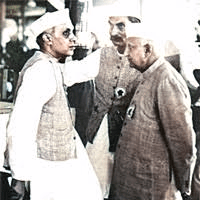In the year 1945, prevailed a rumor that an alliance had taken place between the Congress and the Muslim League. Particularly Bhulabhai Desai, the leader of the Congress parliamentary party and Liaquat Ali Khan, the de facto leader of the Muslim League assembly party were said to be working in close harmony. Desai met Sir Evan Jenkins, private secretary to the Viceroy on 13th January and on 20th January a meeting was held between Desai and Viceroy. The terms of what later came to be known as Desai-Liaqat Pact were conveyed to the Viceroy in this meeting. Desai claimed that Gandhi had supported these terms and Jinnah was also aware of his negotiations with Liaqat Ali Khan and had approved the agreement between them.
According to the Pact: the Congress and the League had agreed to form an interim government in the Center. The composition of such government would be on the following lines: (a) an equal number of persons nominated by the Congress and the League. The persons nominated needs not be the members of the Central Legislature. (b) Representatives of the minorities especially the Scheduled Castes and the Sikhs, and (c) The Commander-in-Chief. The Government would function within the framework of the existing Government of India Act. Moreover, in case such Government is formed, the first step of the Congress and League would be to release the members of the Congress Working Committee.
For the implementation of these recommendations some steps were also suggested. First of all if the Governor General agrees to the suggestions for an interim government in the Center in accordance with the agreement between the Congress and the Muslim League, then he might invite Quaid-i-Azam and Desai either jointly or separately. After they come to an understanding, they would declare that they were prepared to join the Government. The next step would be withdrawal of section 93 in the provinces and form provisional governments on the lines of a coalition.
The Viceroy forwarded these proposals to the Secretary of State for India with the opinion that now they could move forward in the political and constitutional spheres. But the British Government raised some important questions such as what was the guarantee that the interim government would support the war? Would the Congress support Desai? What about the minorities, the non-Congress Hindus and the non-Muslim Leaguers? Was not the pact aimed at depriving the Governor General of his power to select the members of the Council?
Quaid-i-Azam categorically issued a statement disclaiming any knowledge about the pact before the Viceroy could plan to invite him and Desai for seeking answers to the queries raised by the British Government. On the other hand it was amazing that Desai kept on insisting that the pact was valid and that it held the support of both Quaid-i-Azam and Gandhi. For that matter the Viceroy asked Sir John Colville, the Governor of Bombay to look into the matter and meet Quaid-i-Azam on his behalf. When Colville met the Quaid, he again observed that he knew nothing of Desai-Liaquat Pact and that the pact was without the authority of Muslim League. This was the finale of the pact and apparently there was nothing to go ahead.
But the so-called Desai-Liaquat Pact was not an utter failure because of the fact that it paved the way for the Simla Conference. Moreover, once again it made clear to the Congress that Muslim League was the only party, which could represent the Muslims of India.
This article was last updated on Monday, Jan 01, 2007






